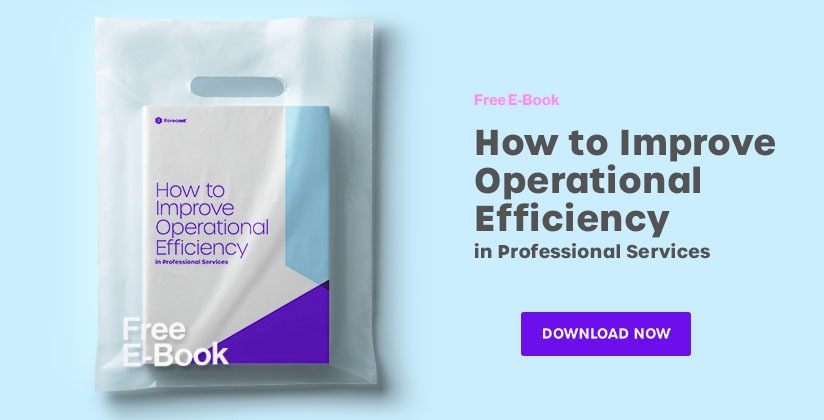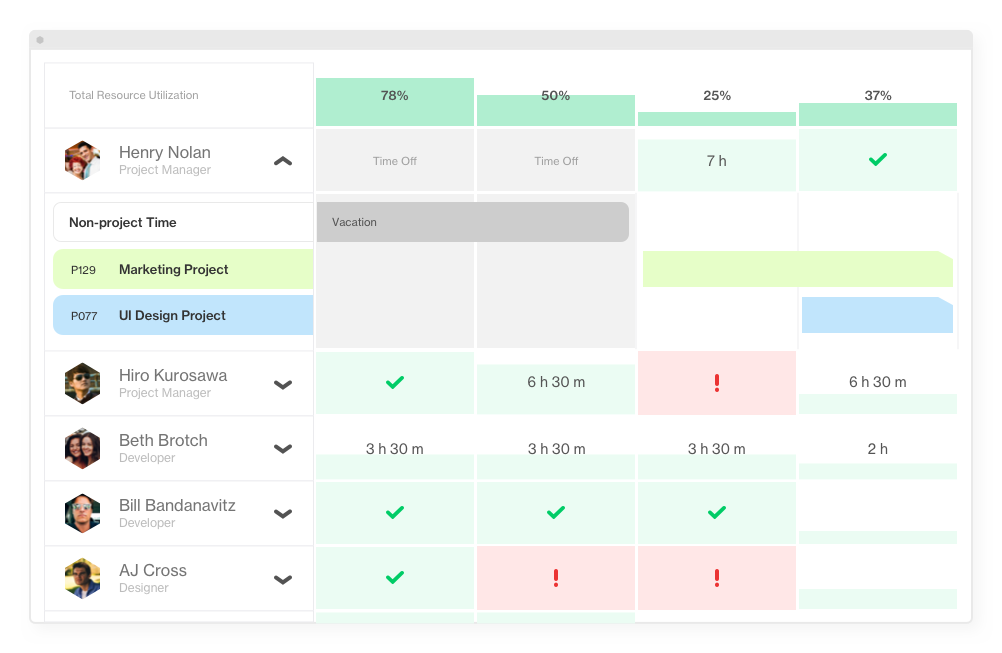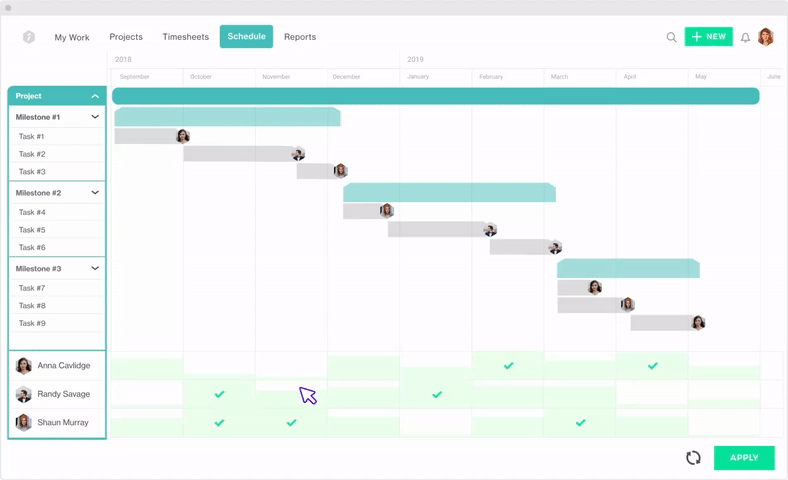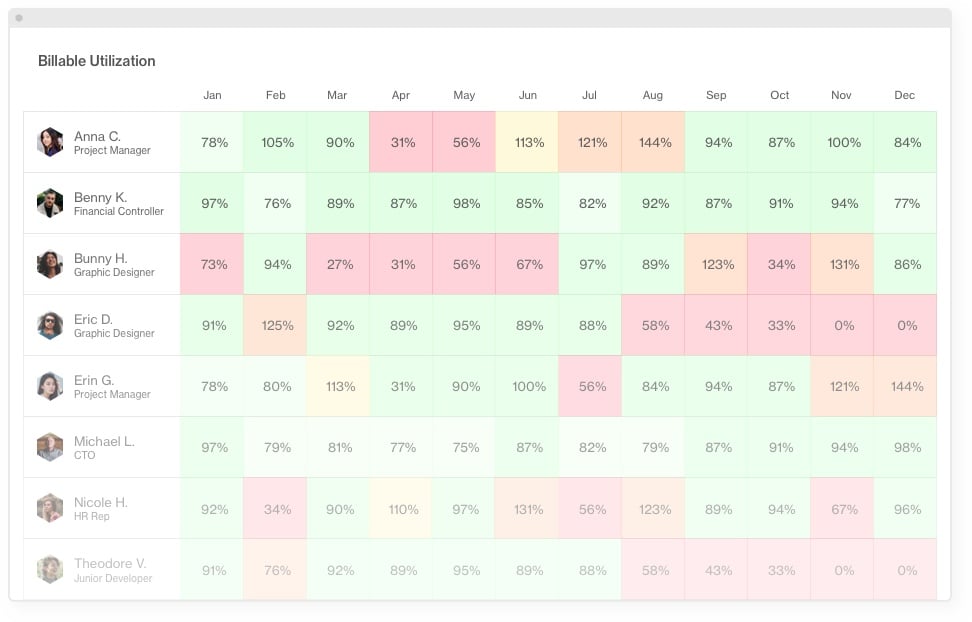6 Resource Allocation Best Practices You Can't Afford to Ignore

83% of executives name resource allocation as the most critical management lever for spurring growth, according to McKinsey.
Sadly, not all companies get the hang of how to do it right. Project and operation managers still fail to use resource allocation to their advantage. Poor resource management has seen the largest increase since 2018 and is now ranked as the 2nd top challenge, remarks Vince Hines, a Managing Director at Wellingtone.
Despite being the most important part of managing any project, the challenge remains how to distribute talent, time, and money in a way that will bring the most value to the organization.
Whether you’re a project manager, looking to improve your project schedules, or a director of operations searching for ways to make the company more profitable through process optimization and resource management, we’ve made this guide to share best practices, methods, and tools to streamline the resource allocation process, based on our own data.
This guide will also show you how to minimize risks in the resource allocation process and save a huge portion of manual work spent connecting pieces of work with the right talent. While it is meant for service-based firms specifically, the concepts here are pretty much applicable to any industry. So, let’s dive in.
The definition of resource allocation
In this article, by resource allocation, we particularly mean the diligent and optimal appointment of resources to do work on the project. People often make the mistake of assuming that resource allocation only involves matching people to tasks. The reality is much different. Effective resource allocation involves much more than just matching a person to a task. Resource allocation definitions we often see are too superficial and a far cry from what happens in reality. De facto, there’s much more significance to what resource allocation involves.
For a minute, try to think of it as an iceberg. What you see above the surface in your projects is a simple picture of delegating assignments, what’s beneath the surface are other factors that affect the process, like resource availability, estimations, dependencies, priorities, change requests, and skills! Seeing only the tip of the iceberg, managers often make a mistake allocating resources by virtue of situations. Strategic decisions that should take into account resource utilization and billability rates are often ignored.
Why resource allocation is important
Allocating resources, project managers should go beyond thinking of just delegating assignments. Here’s why. When you look at the resource allocation process, you will realize that it carries a lot of weight in project management. This is because the manner in which project resources are allocated is what determines if the project will be successful or not.
Eventually, resource allocation affects business performance. Optimal resource distribution is key to the functioning of any organization. When a company allocates its resources, it’s actually determining the resources that will be dedicated to the company’s strategic plans. This means that resource allocation helps organizations put their efforts into the priorities of their operations.
So it’s no secret that the way resources are distributed further affects the company’s operating margin and profit. It wouldn’t be an exaggeration to say that done efficiently, resource allocation makes half of your project done.
Challenges in the resource allocation process
Despite being one of the most important parts of project management, resource allocation remains one of the most difficult processes to automate and optimize. If you’ve worked in any capacity, as part of a project team, then you know that things do not always fall in place as easily when it comes to resource allocation.
In view of the current multiteaming trend, when people are assigned to multiple teams and projects simultaneously, resource allocation becomes even more complicated. When 500 managers in global companies were asked if their team members work on multiple projects in parallel, the majority of 81% said it was true. Other research taking place in knowledge-intensive industries, has shown a higher number of 95%.
Having a shared pool of resources, project managers expand the list of the most common resource allocation questions. It includes but never ends at estimations (often unrealistic), task dependencies (lacking transparency), resource availability (not knowing who’s available and when), priorities (in which sequence that tasks should appear), skills (finding the right role to perform the task). Another factor that commonly prohibits resource allocation is a lack of knowledge and communication between a project manager and the team. A spreadsheet for resource allocation, as experience of many shows, would just be another log in the fire.
Obviously, as a combination of scheduling and staffing decision-making, the process of resource allocation involves just too many things for one human brain to process and handle. To take the guesswork out of resource allocation in 2021 and reduce the number of the administrative challenges, businesses have started to use intelligent project automation software. Today the news is filled with AI, automation and machine learning - we bet you’ve already read a lot about it, but you probably haven’t found the perfect solution to use in your company yet.
In your choice of the perfect solution, think how far you can go with your data. Is filling it in worth your time? Did the information you’d entered became part of the bigger picture or got lost, as if you filled it in a spreadsheet? In other words, have you just put your data to good use? Only platforms that were built with connectivity in mind can translate your data into actionable insights. Forecast is one such platform.
Improving resource allocation
On its mission to reduce human error and automate great parts of administrative work, Forecast has blazed a trail for new, time-saving ways to manage projects, operations, and finances in service industries. To improve resource allocation, a good portion of work relies on how far you can go to connect insights and facts together to make a decision. The platform has a level of connectivity you won’t find elsewhere, so the data you put there becomes part of the bigger picture and never goes unnoticed.
1. Resource availability heat map
First off, your resource allocation strategy always depends on resource availability. In the perfect world, before starting the new project, you’d probably like to see resources available at your company you could assign to the project, or vice versa, people who are over-assigned. The big picture could help you resolve resource conflicts with your fellow project managers and plan with the right utilization insights at hand.
Forecast has a decent overview of resources that updates on the fly, every time a team member is assigned to a task. To give you a better understanding of the subject, we’ve included a few snapshots from our platform, so you can trace how the insights from the article apply to the problem you’re searching to solve. Say, to pick team members for the new project, you can use the above and the following view options instead of an outdated resource allocation spreadsheet:
When you uncover the pulse of your resources, you get a better understanding of how much work they can do (or can’t) over the course of a week—or month.
2. Project and task allocations
So how are resources allocated? A successful resource allocation plan starts with picking one type of resource allocation company-wide. In general, there are two ways you can allocate resources, to projects and to tasks. Forecast caters for both. Selecting one of those will accommodate a better overview of allocations (as on the image above) in the future and allow you to spot who's available easily.
Project allocation
If you don't know upfront what tasks your team will be working on, but you do want to book a team member for let's say 100 hours over the next 3 weeks, you will want to allocate your team members to a project.
Task allocation
Task allocation is essentially a slot of tasks you assign to your team. It works best when you have a list of requirements from your client that can be translated into tasks in advance.
We've noticed a trend that companies on the agile side prefer to allocate their staff to projects, while waterfall method requires more precision, so task allocation seems like a better fit.
3. Auto Schedule with a timeline view
There are a huge number of software options that provide resource maps, but there’s only one that fully automates project planning and scheduling - Forecast. With a click of just one button, its powerhouse of resource allocation algorithms turns your list of tasks into a solid project schedule with the suggested estimates, assigned resources, and realistic deadlines.
But how, you might wonder? It gets to know your resources through their past activities and patterns of behavior and determines the proper timing to allocate resources within the project schedule. Because it resists the urge to over- and underallocate employees, nobody is stressed out or bored at the end of the day.
Auto Schedule can be compared to having more than 40,000 project managers assisting your team in day-to-day work. But they aren't actually there - they are just feeding their information in and making work processes go smoothly for everyone. But more than that, they are also making sure you reduce the human errors. Simply by making small suggestions here and there to optimize and make the decisions stronger.
Now, why timeline view? Some projects are turn-based, following a peculiar game logic, which means waiting until a specific action is completed to begin working on the next task. A built-in order is peculiar for IT companies. If some tasks can only be done on condition that other tasks were completed, it’s best to show them in a timeline view, where the order of tasks is clear.
4. AI-powered estimations
As a rule of thumb, to complete the project plan and allocate resources to tasks, project managers indicate how much effort it is expected for a person to do the task, measured in hours or story points. The point of accurateness to which project managers estimate tasks directly influences the plan and predictions. However, as practice shows, estimates are usually off-the-mark when you switch to the execution phase. To make project planning and scheduling more efficient, you can trust Auto Schedule or benefit from doing estimates manually. Indicate high and low estimate for each task, and Forecast’s AI will suggest a realistic one.
5. Financial overview of role distribution
Resource allocation is the day-to-day problem of both project and operation departments, but it also ties with the financial aspect of the project. How do you track if you’ve allocated resources in the most optimal way from the perspective of profitability? How do you make sure that your resource allocation plan is not just a shot in the dark, but an informed strategic decision? Well, there are ways to see this using Forecast’s Financial Portfolio Report. Both give you actionable financial data without losing reference to roles allocated to the project, from where you can see if the role distribution you’ve chosen contributes to the profitability of each project.
A software development company, for instance, could analyze how many Junior, Middle, and Senior developers are working on the project and based on this information do role-based cost optimization. Another example could be learning resource allocation trends from your past most profitable projects and apply them to similar projects.
6. Resource utilization rates
Another way to spot resource allocation problems is by tracking employee's utilization rate. Utilization, by definition, is the time that's used for productive, billable work, measured in percents. To calculate utilization, the following formula is used:
- Total Billable Hours / Total Hours Available
Many professional services companies consider it a critical metric, and there's a good reason for it. But what does resource allocation has to do with utilization? By quantifying utilization rates, you get a bunch of valuable insights to interpret and feed into the decision-making process when allocating resources. For instance, looking at employee utilization rates and their roles in the company, you can notice where demand is highest. Employees that have record-breaking utilization rates are profit-making and very much in demand. A good overview of utilization rates could help you either identify opportunities to scale the company, or find the most appropriate room to add staff.
Forecast's Utilization Report
Additionally, utilization rates can reveal of few important resource allocation trends across the company. A utilization rate that continually gets closer to 100% is not necessarily a good news worth celebrating. On the contrary, it may serve as a wake-up call that you’re overworking your staff, and it's time to hire new employees. In turn, if a utilization rate is consistently low, it could be a signal that your project is overstaffed and there isn’t enough work to fill the pipeline, or too many hours have been spent on non-billable administrative tasks (such as meetings or training). In any case, utilization rates on either of these two extremes - too high or too low, indicate that your resource allocation processes needs to be revisited.
What’s an optimal utilization rate, then? According to SPI's 2020 Professional Services Maturity Benchmark, billable utilization targets of the best firms average 85% or higher compared to 70% for average firms. "This means top performing consultants bill 300 more hours per year than those at average firms," researchers point out. Let's not forget that higher billable utilization only occurs because the right people with the right skills are available to do the work, which is a direct result of your resource allocation plan.
To wrap it up, good resource allocation should maximize the output of the project at an acceptable cost and with timely delivery. Optimal resource allocation can be hassle-free if you take advantage of automation. The power of intelligent project automation tools like Forecast is in giving you the right insights when you need them and cutting time you spend on administrative work. Imagine the future with this level of transparency. You can start building it today. Sign up for a free trial and benefit from using the platform that connects all the dots together for you.
You might like to read these articles on our blog..
Subscribe to the Forecast Newsletter
Get a monthly roundup of productivity tips & hacks delivered straight to your inbox






